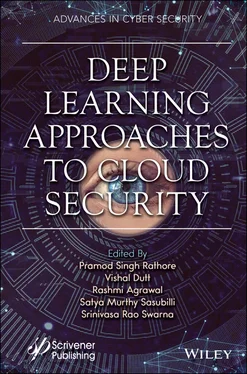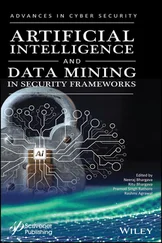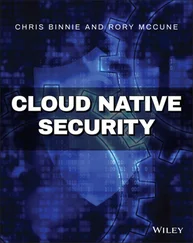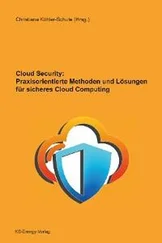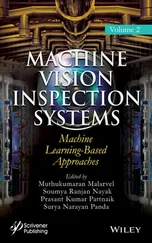Deep Learning Approaches to Cloud Security
Здесь есть возможность читать онлайн «Deep Learning Approaches to Cloud Security» — ознакомительный отрывок электронной книги совершенно бесплатно, а после прочтения отрывка купить полную версию. В некоторых случаях можно слушать аудио, скачать через торрент в формате fb2 и присутствует краткое содержание. Жанр: unrecognised, на английском языке. Описание произведения, (предисловие) а так же отзывы посетителей доступны на портале библиотеки ЛибКат.
- Название:Deep Learning Approaches to Cloud Security
- Автор:
- Жанр:
- Год:неизвестен
- ISBN:нет данных
- Рейтинг книги:3 / 5. Голосов: 1
-
Избранное:Добавить в избранное
- Отзывы:
-
Ваша оценка:
- 60
- 1
- 2
- 3
- 4
- 5
Deep Learning Approaches to Cloud Security: краткое содержание, описание и аннотация
Предлагаем к чтению аннотацию, описание, краткое содержание или предисловие (зависит от того, что написал сам автор книги «Deep Learning Approaches to Cloud Security»). Если вы не нашли необходимую информацию о книге — напишите в комментариях, мы постараемся отыскать её.
Covering one of the most important subjects to our society today, cloud security, this editorial team delves into solutions taken from evolving deep learning approaches, solutions allowing computers to learn from experience and understand the world in terms of a hierarchy of concepts, with each concept defined through its relation to simpler concepts.
Deep Learning Approaches to Cloud Security: Audience:
Deep Learning Approaches to Cloud Security — читать онлайн ознакомительный отрывок
Ниже представлен текст книги, разбитый по страницам. Система сохранения места последней прочитанной страницы, позволяет с удобством читать онлайн бесплатно книгу «Deep Learning Approaches to Cloud Security», без необходимости каждый раз заново искать на чём Вы остановились. Поставьте закладку, и сможете в любой момент перейти на страницу, на которой закончили чтение.
Интервал:
Закладка:
11. Naveen Kumar, Prakarti Triwedi, Pramod Singh Rathore, “An Adaptive Approach for image adaptive watermarking using Elliptical curve cryptography (ECC)”, First International Conference on Information Technology and Knowledge Management pp. 89–92, ISSN 2300-5963 ACSIS, Vol. 14 DOI: 10.15439/2018KM19.
12. Rathore, P.S., Chatterjee, J.M., Kumar, A. et al . Energy-efficient cluster head selection through relay approach for WSN. J Supercomput (2021). https://doi.org/10.1007/s11227-020-03593-4
13. S. Bawaskar and M. Verma, “Enhanced SSO based MultiFactor Authentication for Web Security”, International Journal of Computer Science and Information Technologies, Vol. 7 (2), 2016, 960-966, 2016.
14. S. Ziyad and A. Kannammal, ”A Multifactor Biometric Authentication for the Cloud”, Springer India, Computational Intelligence, Cyber Security and Computational Models, Advances in Intelligent Systems and Computing 246, 2014.
15. Singh Rathore, P., Kumar, A., & Gracia-Diaz, V. (2020). A Holistic Methodology for Improved RFID Network Lifetime by Advanced Cluster Head Selection using Dragonfly Algorithm. International Journal Of Interactive Multimedia And Artificial Intelligence, 6 (Regular Issue), 8. http://doi.org/10.9781/ijimai.2020.05.003.
16. Thangapandiyan, M., Anand, P.M., & Sankaran, K. (2018). Quantum Key Distribution and Cryptography Mechanisms for Cloud Data Security. 2018 International Conference on Communication and Signal Processing (ICCSP), 1031-1035.
17. Joshua C. Klontz, Brendan F. Klare, Scott Klum, Anil K. Jain, Mark J. Burge, “Open source biometric recognition”, Biometrics: Theory Applications and Systems (BTAS) 2013 IEEE Sixth International Conference on, pp. 1–8, 2012.
18. Patil, Archana and Patil, Dr. Rekha, An Analysis Report on Green Cloud Computing Current Trends and Future Research Challenges (March 19, 2019). Proceedings of International Conference on Sustainable Computing in Science, Technology and Management (SUSCOM), Amity University Rajasthan, Jaipur - India, February 26-28, 2019, Available at SSRN: https://ssrn.com/abstract=3355151or http://dx.doi.org/10.2139/ssrn.3355151
19. Sarvabhatla, M., Giri, M., Vorugunti, C.S., Cryptanalysis of cryptanalysis and improvement of Yan et al ., Biometric- based authentication scheme for TMIS, CoRR, 2014.
20. Ziyad, S., & Rehman, S. Critical Review of Authentication Mechanisms in Cloud Computing, (2014).
21. Shruti Bawaskar et al , /(IJCSIT) International Journal of Computer Science and Information Technologies, Vol. 7 (2), 960-966, 2016.
2
Privacy in Multi-Tenancy Cloud Using Deep Learning
Shweta Solanki1* and Prafull Narooka2
1 MDS University Ajmer, Ajmer, India
2 Department of Computer Science, Agrawal College, Merta City, Rajasthan
* Corresponding author: shweta.solanki01212@gmail.com
Abstract
There is a responsibility to maintain the privacy and security of data in the Cloud Computing environment. In present times, the need for privacy is increased due to frequent development in multi-tenant service based systems. As a system of growth increases, the requirement for privacy also increases. We use Deep Learning concepts to increase privacy levels. In this chapter, we understand the cloud computing concept within a Multi-Tenant Framework (MWF). In Multi-Tenant Frameworks, requirements for privacy and security concepts are developed using Deep Learning. The goal is to find privacy requirements across many factors in a Multi-Tenancy based systems using Deep Learning concepts. The services of Multi-Tenant based systems are aggregated due to the dynamic environment of Cloud Computing. Three consistencies will be maintained by privacy policies using Deep Learning. In Multi- Tenancy, a large number of users (tenants) use the same services required for privacy and security to maintain the durability and consistency of service.
Keywords:Multi-tenant, privacy, framework, privacy policy, cloud computing, single tenant, public, private
2.1 Introduction
It is very important to understand the need for Multi-Tenancy in the Cloud Computing environment because today all work is done with the help of an internet transaction mode. In this environment, the database and schema used in the database change or modify frequently. Data is stored in different areas in different databases [1]. The cloud computing environment of every organisation is different. The real need of cloud environment-like private or public modes depends on the concept of data and tenant needs, organisation needs, or the configuration of a database depending on the structure of the database and the model used by the organisation for privacy policies. The security level of the Multi-Tenancy structure should maintain the durability of an application to maintain consistency of the system and avoid interruption of the regular based work done by the tenant. The concept of Multi-Tenancy in multiple databases requires more privacy between tenants both logically and physically to accommodate a greater the need for privacy and security in each work area. Using Deep Learning concepts can improve the complexity in accessing and managing a database. Using Deep Learning concepts should reduce access and increase efficiency, preventing the leak of data, hacking, or other risks because they can be found out easily and improve the quality of Multi-Tenant system efficiency. So, in Deep Learning, the privacy concept is improved and the transparency between the multiple tenants increases, maintaining privacy. Deep Learning concepts are very powerful and scalable for implementing. In Deep Learning, databases are managed efficiently. The Deep Learning algorithm makes this affordable. The Deep Learning concept has the ability to improve data driven predictions. It finds the patterns of privacy and security in databases in Multi-Tenancy. This can provide good or better values for organisation. In Deep Learning, the work is done for binary, category, and value predictions in Cloud Computing. In this chapter, we discuss the basic concept of Multi-Tenancy, privacy requirements, and the Cloud Computing concept with Deep Learning.
2.2 Basic Structure
It is very important to understand Cloud Computing, as it provides service accordingly to its user end. Whether it is a private or public cloud depends the requirement of user, like Multi-Tenancy or Single Tenancy. It is also an on demand service that depends on tenant requirement, resource availability, storage requirement, activity management, and which topology is required for the distributed system. The tenant requires either a centralised or decentralised framework. Security in Cloud Computing also depends on the concept of the database and the need for bigness and organisation. As the need arises, the organisation selects the structure of Cloud Computing. Then, they create the schema and select a data model and select a Single or Multi-Tenancy concept for work. Complexity and cost are also dependent on the requirements of the organisation’s needs. There are structures of Cloud Computing and the Multi-Tenancy concept available illustrating the impact of Multi-Tenancy in Cloud Computing. The cloud manages the concept of Multi-Tenancy, shares resources, and manages services with many tenants. Management and the utility services are provided by the structure according to need. This section discusses the basic structure of Cloud Computing and how the work is done in combination with Multi-Tenancy [2].
2.2.1 Basic Structure of Cloud Computing
Cloud Computing services are used by every service area, whether the business is small or large.
The cloud facility is available according to the requirements of the business. The cloud enables the facility to store data, whether it be large or small, and provides access to data from any location and any hardware or a virtual environments for accessing or storing data.
Читать дальшеИнтервал:
Закладка:
Похожие книги на «Deep Learning Approaches to Cloud Security»
Представляем Вашему вниманию похожие книги на «Deep Learning Approaches to Cloud Security» списком для выбора. Мы отобрали схожую по названию и смыслу литературу в надежде предоставить читателям больше вариантов отыскать новые, интересные, ещё непрочитанные произведения.
Обсуждение, отзывы о книге «Deep Learning Approaches to Cloud Security» и просто собственные мнения читателей. Оставьте ваши комментарии, напишите, что Вы думаете о произведении, его смысле или главных героях. Укажите что конкретно понравилось, а что нет, и почему Вы так считаете.
